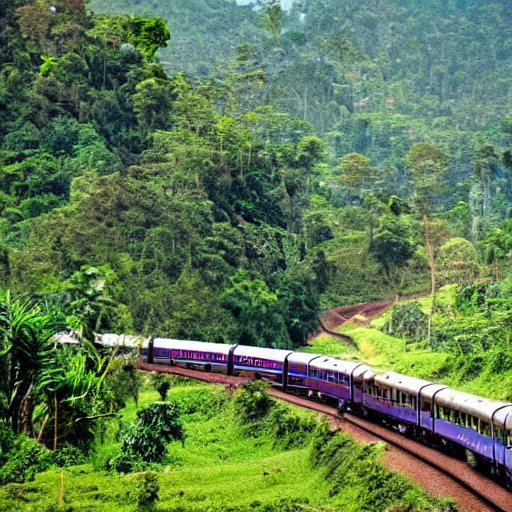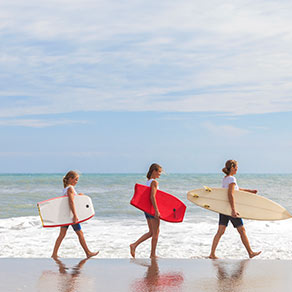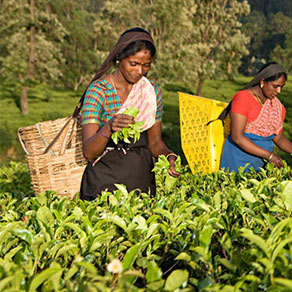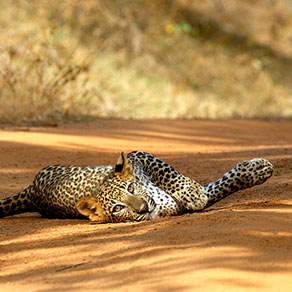A guide to train journeys in Sri Lanka
Sri Lanka’s scenic train journeys are a great way to explore the country’s diverse landscapes, rich cultural heritage, and stunning vistas.
With a well-connected railway network, travellers can experience the changing landscapes, from lush green tea plantations to dramatic coastal views, while soaking in the local culture.

The Sri Lankan railway network, established in 1864 during British colonial rule, initially facilitated the transportation of tea and coffee from the central highlands to the port city of Colombo.
The first railway line, inaugurated in 1865, connected Colombo with Ambepussa. Over time, the network expanded, with the Main Line, Northern Line, and Eastern Line constructed, contributing to the country’s economic and social development.
The railway facilitated cultural exchange and trade between regions, with railway stations becoming vibrant centres of activity. Architecturally, the stations display a blend of Western and local influences, from Victorian to Art Deco styles. Trains and infrastructure components were imported from various countries, including the United Kingdom, Germany, India, and China.
Following Sri Lanka’s independence in 1948, the railway experienced periods of decline due to competition from road transportation, insufficient investment, and the impact of the civil war.
However, recent efforts have focused on modernising and restoring the network. Today, Sri Lanka Railways serves both local commuters and tourists, offering a unique journey through the island’s rich heritage.
Here’s Yonder’s rundown on some of the most thrilling train journeys in Sri Lanka.
The best railway journeys in Sri Lanka
Kandy to Ella
Distance: 158 km
Duration: 6-7 hours
The journey from Kandy to Ella is a must for those who want to experience Sri Lanka’s verdant hill country. As the train winds its way through the highlands, passengers are treated to breathtaking views of tea plantations, dense forests, and picturesque waterfalls. This trip offers travellers the opportunity to witness the island’s unique ecosystem and vibrant local life, with frequent stops at quaint villages and bustling markets.
Colombo to Galle
Distance: 116 km
Duration: 2.5-3 hours
Connecting Sri Lanka’s capital with the historic coastal city of Galle, this journey offers an enchanting glimpse of the country’s southern coastline. The route hugs the shore, providing panoramic views of the Indian Ocean, pristine beaches, and small fishing villages. The journey concludes in Galle, a UNESCO World Heritage site renowned for its well-preserved Dutch-era architecture and vibrant cultural scene.
Anuradhapura to Jaffna
Distance: 165 km
Duration: 3.5-4 hours
Travellers seeking to explore Sri Lanka’s rich history and culture should consider the rail journey from Anuradhapura to Jaffna. This route takes passengers through the island’s northern plains, dotted with ancient cities and archaeological wonders. The train passes through the iconic Elephant Pass, a narrow strip of land connecting the Jaffna Peninsula with the rest of the island, offering stunning views of the Jaffna Lagoon.
Need-to-Know
Train Classes: Sri Lankan trains offer three classes: First Class, Second Class, and Third Class. First Class provides air-conditioning and reserved seating, while Second Class offers comfortable seats with fans, and Third Class has basic bench seating. It is advisable to book tickets in advance, particularly for First and Second Class, as they can sell out quickly during peak travel seasons.
Ticket Booking: Tickets can be purchased at railway stations or through authorised travel agents. Tickets for all rail journeys organised as part of a Yonder trip will be organised on your behalf.
Luggage: There is no strict luggage allowance on Sri Lankan trains, but passengers are expected to store their baggage in the overhead racks or under the seats. It is recommended to keep valuables close at hand and to pack light, as space can be limited, particularly in Third Class.
Food and Drink: Most long-distance trains have a buffet car serving snacks, meals, and beverages. Vendors also board the trains at various stations, offering an array of local delicacies, fresh fruits, and refreshments. It is a good idea to carry your own water bottle and some snacks for the journey.
Etiquette and Safety: When travelling on Sri Lankan trains, it is essential to be mindful of local customs and etiquette. Dress modestly and avoid excessive displays of affection. Engage with locals respectfully, and always ask permission before taking photographs of people or their property. While trains in Sri Lanka are generally safe, exercise caution with your belongings and be aware of your surroundings. Avoid leaning out of open windows or doors, as there may be low-hanging branches or other obstacles along the route.
Accessibility: Although efforts have been made to improve accessibility on Sri Lankan trains, passengers with mobility issues may face challenges, particularly when boarding or disembarking. Assistance is usually available from railway staff, but it is advisable to inform the station or train personnel in advance if you require specific accommodations.
Timetables and Delays: Sri Lanka Railways publishes timetables for all routes, which can be found at railway stations or online. However, train schedules can be subject to change, and delays are not uncommon. It is recommended to arrive at the station well ahead of your departure time and to have a flexible itinerary, as journey durations may vary.
YONDER SUGGESTIONS
Yonder is a specialist India tour operator, including tailor-made, luxury holidays to Sri Lanka which can include any of the must see places discussed in this article.
All Yonder itineraries are crafted on a tailor-made, one-off basis, so you can be sure that your holiday will be as individual as you are.
Sri Lanka’s scenic train journeys are a great way to explore the country’s diverse landscapes, rich cultural heritage, and stunning vistas.
With a well-connected railway network, travellers can experience the changing landscapes, from lush green tea plantations to dramatic coastal views, while soaking in the local culture.
The Sri Lankan railway network, established in 1864 during British colonial rule, initially facilitated the transportation of tea and coffee from the central highlands to the port city of Colombo.
The first railway line, inaugurated in 1865, connected Colombo with Ambepussa. Over time, the network expanded, with the Main Line, Northern Line, and Eastern Line constructed, contributing to the country’s economic and social development.
The railway facilitated cultural exchange and trade between regions, with railway stations becoming vibrant centres of activity. Architecturally, the stations display a blend of Western and local influences, from Victorian to Art Deco styles. Trains and infrastructure components were imported from various countries, including the United Kingdom, Germany, India, and China.
Following Sri Lanka’s independence in 1948, the railway experienced periods of decline due to competition from road transportation, insufficient investment, and the impact of the civil war.
However, recent efforts have focused on modernising and restoring the network. Today, Sri Lanka Railways serves both local commuters and tourists, offering a unique journey through the island’s rich heritage.
Here’s Yonder’s rundown on some of the most thrilling train journeys in Sri Lanka.
The best railway journeys in Sri Lanka
Kandy to Ella
Distance: 158 km
Duration: 6-7 hours
The journey from Kandy to Ella is a must for those who want to experience Sri Lanka’s verdant hill country. As the train winds its way through the highlands, passengers are treated to breathtaking views of tea plantations, dense forests, and picturesque waterfalls. This trip offers travellers the opportunity to witness the island’s unique ecosystem and vibrant local life, with frequent stops at quaint villages and bustling markets.
Colombo to Galle
Distance: 116 km
Duration: 2.5-3 hours
Connecting Sri Lanka’s capital with the historic coastal city of Galle, this journey offers an enchanting glimpse of the country’s southern coastline. The route hugs the shore, providing panoramic views of the Indian Ocean, pristine beaches, and small fishing villages. The journey concludes in Galle, a UNESCO World Heritage site renowned for its well-preserved Dutch-era architecture and vibrant cultural scene.
Anuradhapura to Jaffna
Distance: 165 km
Duration: 3.5-4 hours
Travellers seeking to explore Sri Lanka’s rich history and culture should consider the rail journey from Anuradhapura to Jaffna. This route takes passengers through the island’s northern plains, dotted with ancient cities and archaeological wonders. The train passes through the iconic Elephant Pass, a narrow strip of land connecting the Jaffna Peninsula with the rest of the island, offering stunning views of the Jaffna Lagoon.
Need-to-Know
Train Classes: Sri Lankan trains offer three classes: First Class, Second Class, and Third Class. First Class provides air-conditioning and reserved seating, while Second Class offers comfortable seats with fans, and Third Class has basic bench seating. It is advisable to book tickets in advance, particularly for First and Second Class, as they can sell out quickly during peak travel seasons.
Ticket Booking: Tickets can be purchased at railway stations or through authorised travel agents. Tickets for all rail journeys organised as part of a Yonder trip will be organised on your behalf.
Luggage: There is no strict luggage allowance on Sri Lankan trains, but passengers are expected to store their baggage in the overhead racks or under the seats. It is recommended to keep valuables close at hand and to pack light, as space can be limited, particularly in Third Class.
Food and Drink: Most long-distance trains have a buffet car serving snacks, meals, and beverages. Vendors also board the trains at various stations, offering an array of local delicacies, fresh fruits, and refreshments. It is a good idea to carry your own water bottle and some snacks for the journey.
Etiquette and Safety: When travelling on Sri Lankan trains, it is essential to be mindful of local customs and etiquette. Dress modestly and avoid excessive displays of affection. Engage with locals respectfully, and always ask permission before taking photographs of people or their property. While trains in Sri Lanka are generally safe, exercise caution with your belongings and be aware of your surroundings. Avoid leaning out of open windows or doors, as there may be low-hanging branches or other obstacles along the route.
Accessibility: Although efforts have been made to improve accessibility on Sri Lankan trains, passengers with mobility issues may face challenges, particularly when boarding or disembarking. Assistance is usually available from railway staff, but it is advisable to inform the station or train personnel in advance if you require specific accommodations.
Timetables and Delays: Sri Lanka Railways publishes timetables for all routes, which can be found at railway stations or online. However, train schedules can be subject to change, and delays are not uncommon. It is recommended to arrive at the station well ahead of your departure time and to have a flexible itinerary, as journey durations may vary.
YONDER SUGGESTIONS
Yonder is a specialist India tour operator, including tailor-made, luxury holidays to Sri Lanka which can include any of the must see places discussed in this article.
All Yonder itineraries are crafted on a tailor-made, one-off basis, so you can be sure that your holiday will be as individual as you are.

 GBP
GBP


